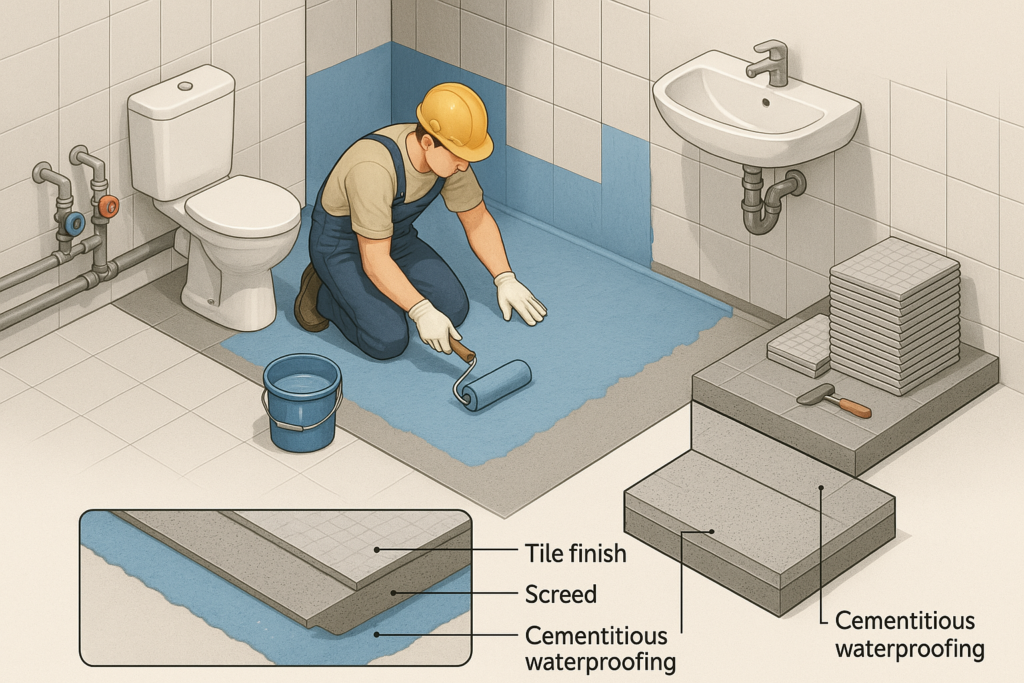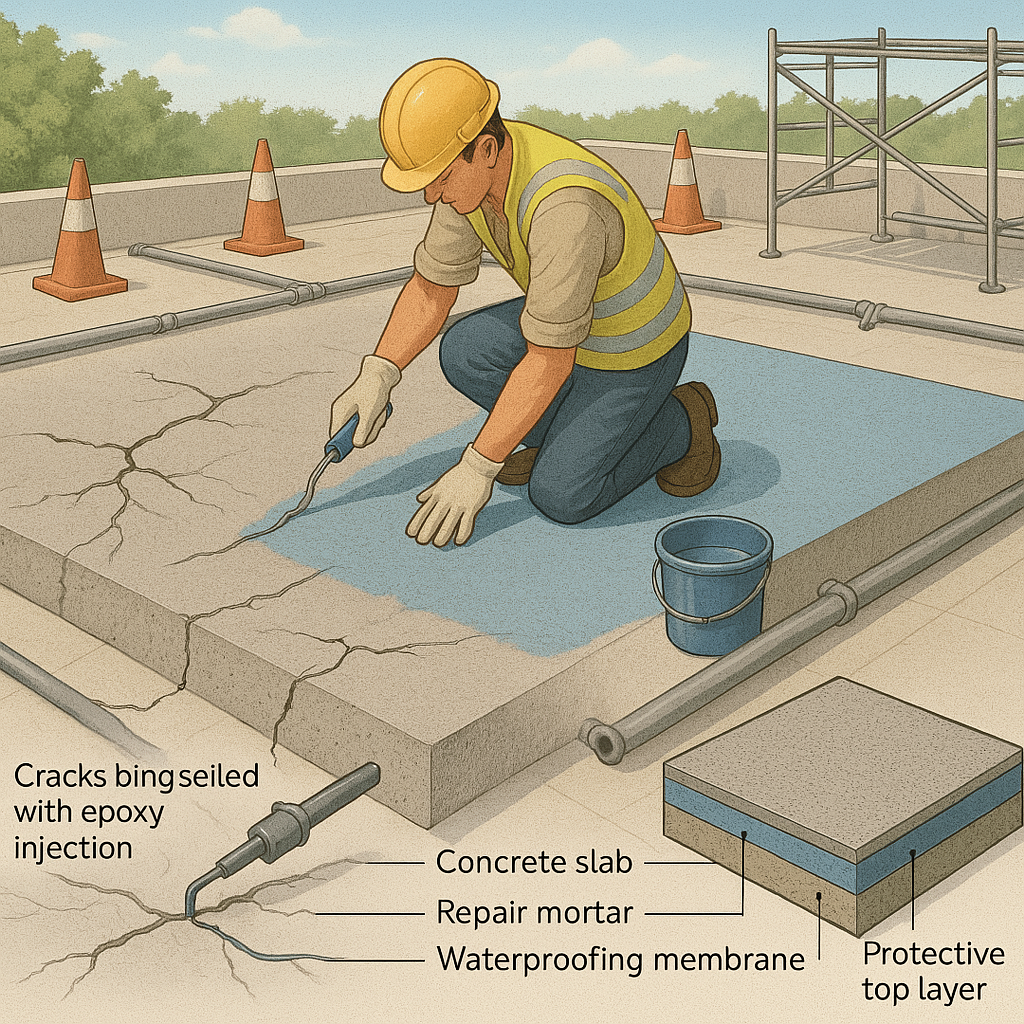Introduction: Why Waterproofing is Essential in Malaysia
In a country like Malaysia, where tropical rainfall and high humidity are a year-round reality, waterproofing isn’t a luxury—it’s a necessity. Without proper waterproofing, structures face a host of problems: leaks, mold, mildew, deterioration of building materials, and costly long-term damage.
This blog serves as your comprehensive guide to waterproofing in Malaysia in 2025—covering proven methods, materials, emerging technologies, and maintenance practices. Whether you’re a homeowner, contractor, or property developer, this guide will help you protect your assets from water damage and enhance building durability.
1. Common Waterproofing Methods in Malaysia
Waterproofing strategies in Malaysia generally fall into four key categories:
1.1 Membrane Waterproofing (Sheet-Based)
| Type | Key Benefit | Common Use |
|---|---|---|
| Bituminous Membranes | Durable & cost-effective | Flat roofs, balconies, basements |
| PVC / TPO Membranes | UV & chemical resistant | Commercial roofs, exposed areas |
| EPDM Rubber Sheets | Highly flexible & durable | Foundations, large roofs |
Membrane waterproofing involves laying pre-fabricated sheets, either torch-applied or self-adhesive, to block water ingress. Torch-on membranes remain a contractor favourite for flat rooftops.
1.2 Liquid-Applied Waterproofing
- Polyurethane (PU): Highly elastic and durable, excellent for rooftops and balconies.
- Acrylic: UV resistant, cost-effective, ideal for walls and general exterior use.
- Bituminous Coatings: Common for basements, bridges, and retaining walls.
These systems are seamless, easy to apply, and flexible—ideal for complex surfaces.
1.3 Cementitious Waterproofing
Popular in bathrooms, balconies, and internal wet areas due to affordability and ease of use. Available in:
- Rigid Cementitious: For internal spaces with no structural movement.
- Flexible Cementitious: For balconies or areas prone to micro-movement.
- Crystalline: A self-healing solution for concrete foundations.
1.4 Specialized Systems
- PU Injection Grouting: For filling structural cracks and leaks.
- Epoxy Coatings: For high-traffic industrial floors.
- Nanotechnology Coatings: Invisible, non-toxic, and suitable for sealing hairline cracks.
2. Waterproofing Materials and Their Performance in Malaysian Climate
| Material | Flexibility | UV Resistance | Durability | Use Case |
|---|---|---|---|---|
| Bitumen | Good | Moderate | 10–20 years | Roofs, basements |
| Polyurethane | Excellent | Good | 10+ years | Exposed areas |
| Cementitious | Rigid | Moderate | 5–10 years | Bathrooms |
| PVC/TPO | Good | Excellent | 15–30 years | Commercial roofs |
| Acrylic | Good | Good | 5–10 years | Walls, terraces |
| Epoxy | Rigid | Poor | 5–10 years | Industrial floors |
| EPDM | Excellent | Good | 15–30 years | Large surfaces |
💡 Pro Tip: For flat roofs, opt for PVC or polyurethane membranes. For internal bathrooms, go with flexible cementitious coatings.
3. Applications by Building Type
Residential Properties
- Flat Roofs: Bituminous, TPO membranes, or PU coatings.
- Bathrooms & Wet Areas: Cementitious coatings + sealants.
- Balconies: Acrylic or PU membranes.
- Basements: HDPE, self-adhesive membranes.
Commercial & Industrial Buildings
- Green Roofs & Podiums: Torch-on bitumen or polyurea systems.
- Heavy-Use Floors: Epoxy coatings for abrasion and chemical resistance.

4. Waterproofing Standards & Regulations in Malaysia
| Standard | Description |
|---|---|
| MS 2529:2013 | Bitumen sheets for damp proofing |
| CIDB CIS 7:2021 (QLASSIC) | Functional assessment of water-tightness in wet areas |
| EN1504 (Recommended) | European standard for repair and protection of concrete |
🔍 Although some practices like bathroom waterproofing remain voluntary, adopting these standards improves safety, durability, and resale value.
5. Lifespan and Maintenance Best Practices
| System | Lifespan | Maintenance Tips |
|---|---|---|
| Torch-on Bitumen | 15–20 years | Check for blistering and cracks annually |
| PU Coatings | 10+ years | Recoat exposed surfaces every 5 years |
| Cementitious | 5–10 years | Reapply in high-use wet areas |
| PVC / TPO | 15–30 years | Inspect seams regularly |
| Epoxy | 5–10 years | Avoid harsh UV exposure |
✅ Conduct semi-annual inspections, clear debris from drains, and act fast on any surface damage.
6. Innovative Waterproofing Technologies in 2025
Waterproofing is becoming smarter and more sustainable. Key innovations in Malaysia include:
- Smart Waterproofing (IoT Sensors): Real-time leak detection systems.
- Self-Healing Membranes: Membranes that auto-seal small cracks.
- Nanotechnology Coatings: Ultra-thin, invisible waterproof barriers.
- Eco-Friendly Products: VOC-free and green-certified options.
- Polyurea Coatings: Rapid-curing, long-lasting membranes ideal for commercial surfaces.
- MM6130K Monolithic Systems: A seamless solution now used in green roof and podium applications in Malaysia.
7. Why You Need Pro Inspect Solution for Waterproofing Inspection
Before applying waterproofing—or even after a building is completed—it’s critical to inspect the site for vulnerabilities. That’s where Pro Inspect Solution comes in.
What They Offer:
- Pre-installation moisture analysis
- Post-installation waterproof integrity tests
- Basement leak detection & diagnosis
- External and roof membrane condition assessments
🔍 Use Pro Inspect Solution to identify potential risks, ensure waterproofing quality, and avoid thousands in water damage repairs.
Whether you’re a contractor or homeowner, their certified experts help protect your property—from ground to roof.
Conclusion: Building Dry, Building Smart in 2025
Waterproofing in Malaysia is no longer optional—it’s mission-critical to maintaining property value and structural integrity. As building materials and technologies evolve, so must your waterproofing strategy.
🏗️ Whether you’re tackling a flat roof, a basement, or a luxury condo balcony—choose the right materials, follow industry best practices, and work with professional inspection teams like Pro Inspect Solution to ensure durability.
💡 Remember: Waterproofing is cheaper as prevention than as a fix. Don’t let water win.
FAQs: Waterproofing in Malaysia
1. What is the best waterproofing system for flat roofs in Malaysia?
Polyurethane or PVC/TPO membranes are ideal due to their flexibility and weather resistance.
2. How long does waterproofing last in Malaysian climate?
Depending on the material, between 5 to 30 years with proper maintenance.
3. Are waterproofing standards in Malaysia mandatory?
Most are voluntary, but following standards like MS 2529:2013 and CIS 7:2021 is highly recommended.
4. Is it worth hiring an inspection company like Pro Inspect Solution?
Absolutely. Their pre- and post-installation inspections help catch issues early, ensuring better ROI and long-term protection.


